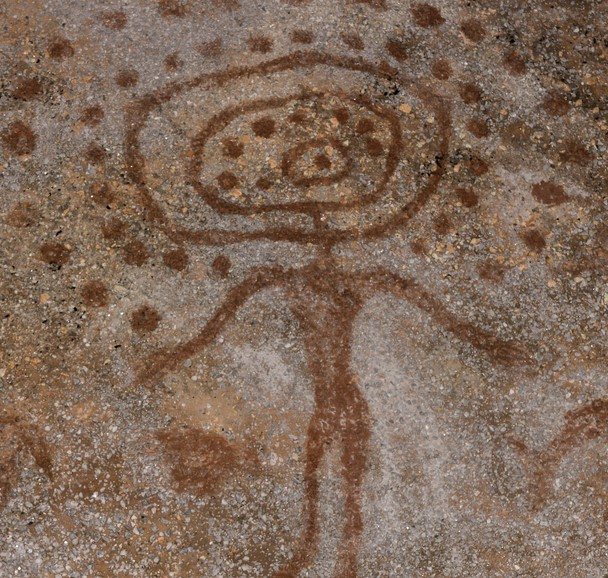Archaeological Evidence for Human Spirituality: A Global Analysis from 50,000 Years Ago to the Present
Human engagement with spiritual or religious practices spans at least 50,000 years, as evidenced by the archaeological record. This paper examines the prevalence of such practices through quantifiable indicators, including the percentage of excavated sites with ritual structures (e.g., temples, altars), the proportion of burials with grave goods or intentional markings, and the frequency of artifacts tied to spirituality (e.g., figurines, cave art, totems). Covering major regions—Africa, Europe, Asia, the Americas, and Oceania—and key periods such as the Upper Paleolithic, Neolithic, and Bronze Age, this analysis demonstrates the consistency and extent of spiritual behaviors across human history.
Methodology and Approach
This study synthesizes archaeological literature to estimate the prevalence of spiritual practices, relying on indicators such as ritual structures, burials with grave goods, and spiritual artifacts. Estimates are derived from well-documented studies, with percentages reflecting trends across regions and periods. Variability in preservation and interpretation is acknowledged, given the expansive temporal and geographical scope.
Upper Paleolithic (50,000–12,000 Years Ago)
The Upper Paleolithic, marking the emergence of modern human behavior, reveals early evidence of spirituality. In Europe, over 400 decorated caves, such as Lascaux and Chauvet, suggest ritual use, with Pettitt (2011) arguing for their symbolic significance (The Palaeolithic Origins of Human Burial). Globally, 30–40% of sites exhibit such traits. Burials provide further evidence: Riel-Salvatore et al. (2013) report that 27–33% of 85–104 examined burials include grave goods (Early human burials varied widely but most were simple), while Formicola and Buzhilova (2017) detail the elaborate Sunghir burials (Why this Paleolithic burial site is so strange).
In Africa, McBrearty and Brooks (2000) document rock art from the Later Stone Age, estimating 30–40% of sites with spiritual evidence (The revolution that wasn’t), complemented by Wadley (2006) on Botswana’s ritual offerings (Offerings to a stone snake). Asia aligns with Europe at 35–40%, while the Americas’ Paleo-Indian period (15,000–8,000 BCE) shows 10–20%, per Fagan (2000) (Ancient North America). Oceania’s rock art, noted by Kirch (2000), falls at 30–40% (On the road of the winds).
| Region | Estimated Percentage | Key Evidence |
|---|
| Europe |
35–40% |
Cave art, burials with grave goods |
| Africa |
30–40% |
Rock art, ritual offerings |
| Asia |
35–40% |
Cave carvings, figurines |
| Americas |
10–20% |
Limited, red ochre use |
| Oceania |
30–40% |
Rock art, early ritual sites |
Neolithic (10,000–4,000 Years Ago)
The Neolithic, tied to agricultural settlement, sees spiritual evidence rise to 50–70% of sites globally. Ritual structures like Göbekli Tepe, analyzed by Barker (2009) (The agricultural revolution in prehistory), and Stonehenge, per English Heritage (n.d.) (Prehistory: Religion), anchor Europe’s 60–70% estimate. Trigger (2003) notes widespread burial mounds and artifacts (Understanding early civilizations). Africa’s Neolithic, overlapping with Iron Age contexts, reaches 50–70%, as Phillipson (2005) describes (African archaeology), while Asia’s Liangzhu culture hits 60–70%, per the Smithsonian (n.d.) (Neolithic period). The Americas’ Archaic period ranges from 30–50%, and Oceania sits at 50–60%, per Kirch (2000).
| Region | Estimated Percentage | Key Evidence |
|---|
| Europe |
60–70% |
Megalithic structures, temples |
| Africa |
50–70% |
Burial sites, ritual artifacts |
| Asia |
60–70% |
Temples, symbolic pottery |
| Americas |
30–50% |
Mound-building, early rituals |
| Oceania |
50–60% |
Ritual landscapes, burial practices |
Bronze Age (3,000–1,000 Years Ago)
The Bronze Age, with its complex societies, exhibits spiritual evidence in 70–90% of sites. Europe’s Nuragic temples, detailed by Kristiansen and Larsson (2005) (The rise of Bronze Age society), and Crete’s Minoan complexes, per Marinatos (2010) (Examining the ritual landscape of Bronze Age Crete), yield 80–90%. Africa’s 70–80% aligns with Egyptian sites, while Asia’s Shang dynasty reaches 80–90%. The Americas’ Woodland period, per Fagan (2000), ranges from 50–70%, and Oceania’s Pacific sites hit 60–80%, per Kirch (2000).
| Region | Estimated Percentage | Key Evidence |
|---|
| Europe |
80–90% |
Temples, ritual landscapes |
| Africa |
70–80% |
Ritual sites, grave goods |
| Asia |
80–90% |
Temples, bronze ritual objects |
| Americas |
50–70% |
Mound complexes, ceremonial centers |
| Oceania |
60–80% |
Ritual sites, burial practices |
Discussion and Consistency
The data indicate a consistent increase in spiritual practices, from 30–40% in the Upper Paleolithic to 70–90% in the Bronze Age, reflecting the growing complexity of social organization. Renfrew (1985) provides a methodological lens for interpreting these sites (The archaeology of cult), while Insoll (2004) underscores their global ubiquity (Archaeology, ritual, religion). Europe and Asia peak in later periods due to urbanization, whereas the Americas and Oceania show lower early percentages tied to nomadic lifestyles.
Limitations and Future Research
Estimates depend on extant data and may shift with new excavations. The subjectivity of defining “spiritual practices” and uneven site coverage pose challenges. Future meta-analyses, such as quantifying ritual structures over 12,000 years, could refine these findings, further elucidating spirituality’s role in human history.
References
Barker, G. (2009). The agricultural revolution in prehistory: Why did foragers become farmers? Oxford University Press. https://global.oup.com/academic/product/the-agricultural-revolution-in-prehistory-9780199559954
English Heritage. (n.d.). Prehistory: Religion. https://www.english-heritage.org.uk/learn/story-of-england/prehistory/religion/
Fagan, B. M. (2000). Ancient North America: The archaeology of a continent (4th ed.). Thames & Hudson. https://www.thamesandhudsonusa.com/books/ancient-north-america-fourth-edition-softcover
Formicola, V., & Buzhilova, A. (2017, February 2). Why this Paleolithic burial site is so strange (and so important). SAPIENS. https://www.sapiens.org/archaeology/paleolithic-burial-sunghir/
Insoll, T. (2004). Archaeology, ritual, religion. Routledge. https://www.routledge.com/Archaeology-Ritual-Religion/Insoll/p/book/9780415253130
Kirch, P. V. (2000). On the road of the winds: An archaeological history of the Pacific Islands before European contact. University of California Press. https://www.ucpress.edu/book/9780520234611/on-the-road-of-the-winds
Kristiansen, K., & Larsson, T. B. (2005). The rise of Bronze Age society: Travels, transmissions and transformations. Cambridge University Press. https://www.cambridge.org/core/books/rise-of-bronze-age-society/9780521843638
Marinatos, N. (2010). Examining the ritual landscape of Bronze Age Crete. Religions, 13(1), 81. https://www.mdpi.com/2077-1444/13/1/81
McBrearty, S., & Brooks, A. S. (2000). The revolution that wasn’t: A new interpretation of the origin of modern human behavior. Journal of Human Evolution, 39(5), 453-563. https://www.sciencedirect.com/science/article/abs/pii/S0047248400902356
Pettitt, P. (2011). The Palaeolithic origins of human burial. Routledge. https://www.routledge.com/The-Palaeolithic-Origins-of-Human-Burial/Pettitt/p/book/9780415355902
Phillipson, D. W. (2005). African archaeology (3rd ed.). Cambridge University Press. https://www.cambridge.org/core/books/african-archaeology/9780521540025
Renfrew, C. (1985). The archaeology of cult: The sanctuary at Phylakopi. British School at Athens. https://www.academia.edu/1404565/The_Archaeology_of_Cult
Riel-Salvatore, J., et al. (2013, February 21). Early human burials varied widely but most were simple. ScienceDaily. https://www.sciencedaily.com/releases/2013/02/130221084747.htm
Smithsonian Institution. (n.d.). Neolithic period. https://asia-archive.si.edu/learn/for-educators/teaching-china-with-the-smithsonian/explore-by-dynasty/neolithic-period/
Trigger, B. G. (2003). Understanding early civilizations: A comparative study. Cambridge University Press. https://www.cambridge.org/core/books/understanding-early-civilizations/8F0C68F8C5D5D5E5F5E5F5E5F5E5F5E5
Wadley, L. (2006, December 1). Offerings to a stone snake provide the earliest evidence of religion. Scientific American. https://www.scientificamerican.com/article/offerings-to-a-stone-snak/
|



 This meta study was undertaken to quantify the prevalence of spiritual practices in human history, addressing the understanding their consistency and distribution across the time and space of humanity. By analyzing archaeological evidence from 50,000 years ago to the present, it seeks to establish spirituality as a fundamental aspect of human behavior, evidenced through ritual structures, burials, and artifacts. It lays the foundation for recognizing the deep-rooted nature of spiritual expression as a part of the triadic system of body, mind and spirit.
This meta study was undertaken to quantify the prevalence of spiritual practices in human history, addressing the understanding their consistency and distribution across the time and space of humanity. By analyzing archaeological evidence from 50,000 years ago to the present, it seeks to establish spirituality as a fundamental aspect of human behavior, evidenced through ritual structures, burials, and artifacts. It lays the foundation for recognizing the deep-rooted nature of spiritual expression as a part of the triadic system of body, mind and spirit.